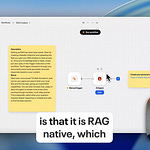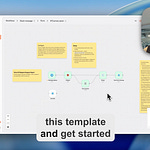I’ve been thinking a lot about friction lately.
Not the physics kind - the interaction kind. The small moments of resistance that stop us from using technology when we need it most.
Last week, I was walking to a client meeting and needed to recall specific details from our last conversation. But opening my laptop, finding the right note, and scrolling through documentation would take 5+ minutes I didn’t have.
So I asked myself: what if I could just... ask?
That’s what led me to build the workflow I’m showing in the video above. A voice AI assistant that lives in Telegram, searches through your knowledge base semantically, and responds in seconds.
What This Video Shows You
In the tutorial, I walk through the complete technical implementation:
Setting up Telegram bot webhooks for voice messages
Voice transcription with AssemblyAI
Workflow automation with Needle
Semantic document search with Needle’s RAG
Building the complete pipeline from voice input to intelligent response
Build time: 1-2 hours
Cost: Free tier available for all services
Difficulty: Beginner-friendly with basic API knowledge
Why This Matters More Than Just Another Tutorial
Here’s what I realized while building this:
Most AI assistants optimize for sitting at a desk. They assume you have time, attention, and a keyboard. But the moments when you need information most are often when you have the least time to search for it.
Voice changes everything. Not because it’s futuristic or trendy - but because it removes friction at the exact moment friction is most painful.
When you’re walking between meetings. When you’re driving. When your hands are full. When you’re multitasking.
This isn’t about replacing typing. It’s about meeting people where they already are - in their daily messaging apps, using their voice naturally.
What I Learned Building This
1. Context is everything
Traditional search looks for keywords. RAG understands meaning. When you ask “What did we discuss about pricing?” - it doesn’t just find the word “pricing.” It understands that contracts, proposals, negotiations, and budget discussions are all relevant.
That semantic understanding is what makes this feel intelligent rather than mechanical.
2. Latency kills voice UX
With text interfaces, users expect a few seconds of delay. With voice, anything over 3-4 seconds feels broken. Every millisecond matters.
That’s why choosing the right transcription service, optimizing your workflow, and managing your context window size all matter more than you’d think.
3. The best interfaces disappear
You don’t think about using Telegram. You don’t think about sending voice messages. The interface is so familiar it’s invisible.
That’s exactly what makes this powerful. You’re not learning a new tool - you’re using tools you already know in a new way.
Real Use Cases I Didn’t Expect
I built this thinking it would be useful for client meetings. But once it was running, I found myself using it for:
Quick fact-checking during phone calls
Research while commuting
Document location when I can’t remember file names
Context retrieval before writing important emails
The pattern: it’s most valuable when you need information immediately but can’t stop what you’re doing to search for it.
Your Turn
The video above walks through everything step-by-step. Grab the workflow template from the comments and start building.
But more importantly: think about where friction exists in your workflow. Where do you need information but don’t have time to search? Where would voice remove the barrier between question and answer?
That’s where tools like this become indispensable.
Watch the full tutorial above ↑
Get the workflow template: https://needle.app/workflow-templates/voice-to-text-telegram-support
What would you use a voice AI assistant for? Hit reply and let me know - I read every response.
Jan
P.S. If you build something with this approach or have questions about the implementation, tag me on LinkedIn or Twitter. I love seeing what people create with these workflows.











